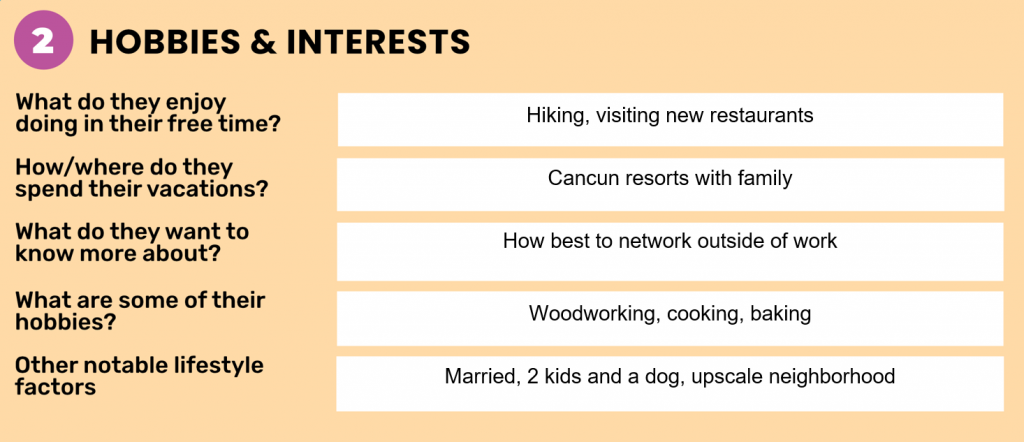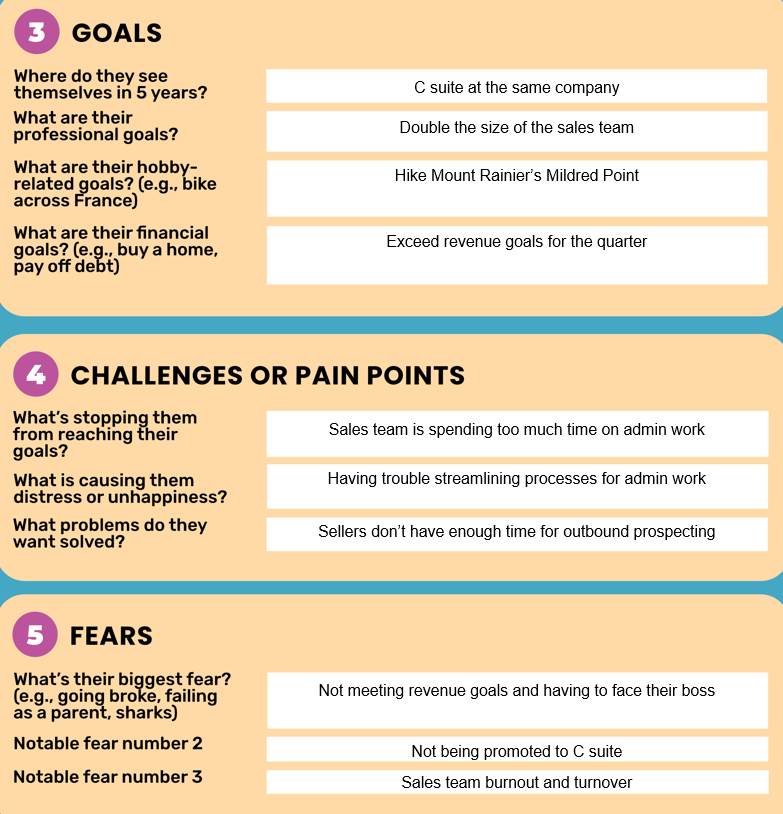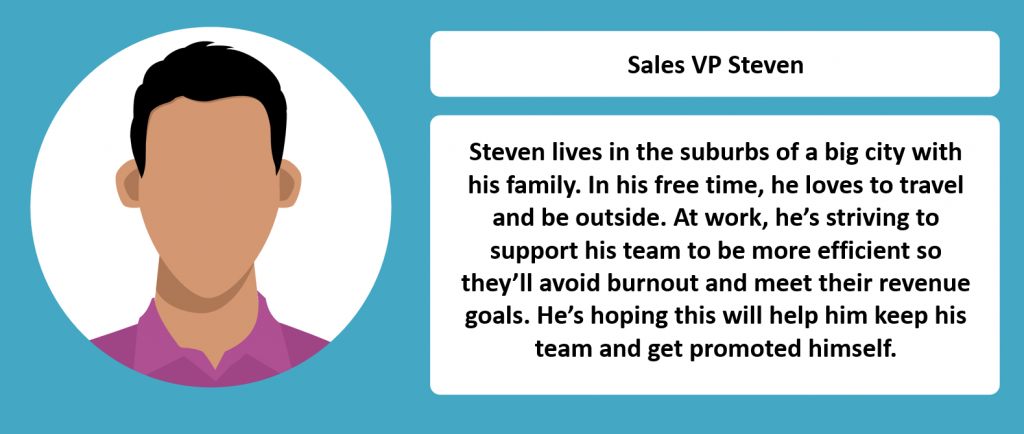Learn the differences between leads, prospects, and opportunities. Understand how to turn leads into prospects and opportunities.
A buyer persona is a categorical description of a fictitious ideal buyer. It typically shares the individual’s demographics, hobbies and interests, goals, and other important intel that businesses can use to make strategic decisions about marketing, sales, and product. Salespeople, in particular, use buyer personas to spot high quality leads who will stay with their brand for a long time and also to craft messaging that speaks to those leads' needs and interests.
B2B and B2C businesses craft buyer personas so they can better understand their ideal buyers, then they use that knowledge to find lookalike leads and sell and market to them effectively. A high-quality buyer persona is often a brief document containing 5–8 sections of info based on current or target customer interviews, surveys, and social and CRM data. The persona usually also incorporates the hard data from their customer profile, which describes a company’s customer base as a whole.
A buyer persona typically includes the following key sections:
Using a descriptive name like “IT Director Dan” can help you categorize your buyer persona, and an image, cartoon or real, humanizes the individual.
This includes information about the person’s age, location, marital status, education, and other details about them as an individual.
Knowing a buyer’s hobbies, interests, free time activities, ideal vacations, schedule, and more enables sellers to more easily connect with a buyer.
This is usually broken into three sections: goals, fears, and challenges. Understanding what motivates your buyer makes influencing them easier.
Understanding where your ideal buyers are active online, what information they consume, and how they like it served helps you more easily market and sell to your target audience.
The first step to creating a buyer persona is finalizing your customer profile via interviews, surveys, and online research. Next, you'll choose the categories you want to include in your buyer persona and start filling them out using additional research and interviews. If you sell to more than one type of buyer, you might create multiple personas so you can tailor your messaging. Also, consider making negative personas describing leads you don’t want so you can disqualify bad leads.
We created a free general buyer persona template that includes sections for an ideal buyer’s demographics, hobbies and interests, goals, challenges, fears, and communication channels — all the vital elements. You can download this template and use it directly to create a persona or simply reference it as a guide. Feel free to add sections or questions that relate to the information you specifically want to know about your ideal buyer — the details that help them sell effectively.
There is a specific step-by-step process you can follow to create an effective buyer persona. It begins with finalizing your customer profile using customer research. From there, choose which persona categories to include and conduct some interviews with current or ideal customers to fill out the buyer persona. Lastly, name the persona and create some sales messaging around it to improve your lead generation process. Let’s go over each step using our filled-out free template.
A customer profile is a data-backed list of your customers' general traits. It includes data about their demographics, psychographics, behavior, geographics, firmographics, and technographics. You’ll be able to use your customer profile to fill out your buyer persona. For example, if your profile lists your customers’ values as “being outdoors,” one of your hobbies in the buyer persona could be specifically “skiing.”
To create your customer profile, follow these steps:
A customer profile not only helps you create your buyer persona. It also enables you to understand your customers on a deeper level. With the hard data on your customers, you’ll be able to enact more targeted marketing and sales campaigns. We therefore recommend handling the profile before the persona. But, if you just want to create a persona, you can do that too, as long as you collect ideal buyer information as you flesh one out.
Pick categories and subcategories (i.e., the questions you’ll ask) to include in your buyer persona. Select ones that uncover information that you need to more effectively qualify and sell to leads. Most companies use demographics, hobbies and interests, goals, challenges, fears, and communication channels, but feel free to add more sections as needed. For example, a financial services business might add a financial section describing spending habits, wealth, and more.
To speed up the process, you can also use buyer persona templates, which are fill-in-the-blank documents that prompt you to answer questions about your buyer. They often contain sections for demographics, hobbies and interests, challenges, goals, fears, and communication channels, but can also contain industry or scenario-specific sections.
Even if you’ve already interviewed some customers for your customer profile, more data can only help, and the buyer persona includes certain sections like goals and challenges that you may not have asked about in customer profile interviews. Time to fill in the gaps. To start, schedule phone or video interviews with ideal customers, ask questions according to your subcategories, and analyze the answers to find commonalities so you create the most accurate snapshot of an ideal buyer.
Here are the steps for interviewing your current or ideal customers:
If you’re a new business and need to interview potential customers instead of current ones, create a simple, rough draft persona based on online market and/or competitor research. It could even just list their job title. Then, tap into your network or search online (such as LinkedIn) for people who seem like the rough persona, and ask if they’d be willing to answer a few questions. Use their answers to update and edit the rough draft in the following steps.
The demographics section should be easy to fill out using the information you gathered for your customer profile, your buyer persona interviews, and/or your CRM. Pick an age, gender, occupation, location, and education level for your buyer persona. If you’ve received multiple answers, such as three common occupations, pick the one that pops up most often, or that is most ideal for your business. For ranges like age, pick somewhere in the middle between the two extremes.
Specifically, consider these three sources when filling out demographics:
More than anything, the demographics section will help you visualize an actual person. Plus, details like education level might affect the level of complexity of your sales writing or other messaging.
Here's an example of a filled-out demographics section using our free template:

Next, fill in the hobbies and interests section, which will include such fields as the buyer’s hobbies, interests, ideal vacation, favorite TV shows and books, and other details about how they spend their time outside of work. Most of these answers will come from your customer interviews or customer profile. But, once again, you may have to do more to fill in the gaps.
Below are some other ways to find information about your ideal buyer’s hobbies and interests:
If you’re a B2C business, this can be a valuable section, since you might be selling products that enhance a customer’s experience during certain hobbies, like a hiking pole or a golf club. If you’re a B2B company, at the very least, knowing your ideal buyer’s lifestyle helps you relate to your target buyer by easily finding avenues for connection. And increased rapport can lead to sales.

Using the most popular answers from your customer interviews, list three goals, three challenges, and three fears that your buyer experiences — these make up your buyer's motivations. Knowing what motivates a buyer to take action will help you to create content and sales messaging that influences your leads to buy your solution or take a meeting.
Sometimes it helps to create connections between the three types of motivations. For example, goal 1 could be hitting quota, challenge 1 could be poor quality leads, and fear 1 could be losing the respect of upper management. You can then mention all three in a sales email, thereby involving three of their emotions: hope, frustration, and worry. Knowing the inner workings of your potential buyers’ minds helps you position your solution in a way that speaks to their souls.

Write down how, when, and where your buyers spend their time online and prefer to communicate. This data, which you can find through interviews and surveys, helps you choose where to run ad campaigns and how to do your cold outreach. For example, if your buyers are all over Instagram, it’s a good idea to run ads there. If they’re averse to taking phone calls from strangers, you’d likely email. This understanding will make successful communication more likely.
Another way to find out what communication channels your buyers prefer and use is by analyzing your CRM and marketing automation software data. These track communication history with your customers and may also inform you on what pages they visit, what blog posts they read, how they usually reach out to your sales team, and more.

Finally, give your character life by naming them using the following formula: {Crucial Attribute + First Name}. A crucial attribute in B2B would likely be their job title or authority. Influencer Ingrid would represent those in target companies without decision-making power but influence over upper management. In B2C, the attribute might be a favorite hobby, life stage, or other factors that suggest their main need. Marathon Mark, for example, needs help running his marathon.
Here are some example buyer persona names:
Aside from sounding pleasant, alliteration helps the names stick in the mind. The main point of naming your buyer persona is to make them feel alive and real. And, if you’re practicing cold calling this buyer persona, it helps to have a name to use. Plus, you can use these names as the title so reps and marketers can easily find the online document when they need it.

Now that your buyer persona is complete, craft or update messaging that you can use to talk with this type of lead. Here are some types of sales resources to create for this specific ideal buyer:
You might also want to get into the weeds regarding the lingo you should use when talking to this type of buyer. For example, in property management, NYC managers call tenants what managers from certain states call residents. This refined messaging will give you a better chance of connecting with and sparking interest in your leads.
Below are four examples of buyer personas — we've created these examples by filling out our own free buyer persona templates (you can download the fresh templates in our buyer persona templates article). Peruse these examples to get a sense of what a finished buyer persona looks like.
The below B2B buyer persona example contains many of the key sections like goals, fears, and challenges, while also including a section for job responsibilities to help sellers better understand what this professional does on a daily basis at their company.
Below is a B2C buyer persona example that includes all the necessary sections of an effective buyer persona: Demographics, goals, fears, challenges, hobbies & interests, and communication channels. To create it, we filled out our B2C persona template for a fictional financial advisor.
This B2B buyer persona example is an abridged version of the more detailed version to the left. A short-form handout like this might rest on a salesperson’s desk as they place cold calls or talk with prospects. It captures the most crucial details like a person’s motivations. However, since it lacks information about a person’s job responsibilities or communication channels, it’s probably not suitable for ad or marketing strategy.
Below is an example of a buyer persona that B2C businesses might create as a handout that’s short and sweet, making it easy to reference. It includes most of the important details like the person’s challenges, goals, and fears, but leaves out some other factors that might be more pertinent to marketing decisions. This type of persona is better suited for salespeople who need a quick refresher on a specific type of buyer.
When creating your buyer persona, examples like the above are excellent resources. They can provide inspiration for your writing, structure, categories, and more. That said, there are also online tools you can use to help you craft an effective persona.
There are various online tools that can support you in the different steps involved in making your buyer persona. For instance, SurveyMonkey and Zoom can help you gather information about your ideal buyers, and HubSpot’s Make My Persona tool can help you quickly input your findings into a professional looking document.
What It’s Right For: Sending surveys to gather data to fill in your buyer persona categories.
SurveyMonkey is a free survey software that helps you easily create surveys to send out to current or ideal customers so you can ask them questions to fill in your persona. The tool also enables you to quickly analyze the answers so that you can choose the most popular answers to put in your persona. You can use this to find answers to any category in your persona.
What It’s Right For: Holding interviews with current customers or, if you’re new, ideal buyers in your target audience.
Zoom is a secure and easy-to-use videoconferencing software that allows you to hold virtual meetings with ideal buyers. As long as you get the person’s permission, you can record videos so after your interviews, you can watch them and write down the answers. Waiting to do this afterward allows you to stay present during the call and focus on asking follow-up questions that dig deeper rather than on writing down their answers.
What It’s Right For: Quickly drafting a basic, well-designed buyer persona.
HubSpot’s Make My Persona tool walks you through the process of filling out the different categories of a basic buyer persona. After filling it out and finishing it on the software, the company will generate the simple buyer persona, taking into account all your answers, and email it to you. The final product will look professional, neat, and well-designed.
Consider where you currently hold data and how you'd like to collect more for your buyer personas, then look into these tools or others that you believe will help you do so efficiently.
Marketers and salespeople can use buyer personas to their advantage in a variety of ways. They can use them to spot higher-quality leads, qualify them more quickly, and close deals faster with personalized customer journeys and messaging. Plus, retaining customers will be easier as well, since you know what makes them tick. Not to mention, this document will help new reps quickly learn about their target prospects.
A buyer persona is a valuable resource that helps in many domains of your business, from sales and marketing to product and customer service. Remember to consistently update your persona when new and relevant customer information arises so that your understanding of your ideal buyer is always fresh and up to date.
A buyer persona describes one person who could be a customer, while a customer profile describes a segment of current customers. Where a buyer persona says gender = male, a customer profile says gender = 65% M, 35% F. A buyer persona helps businesses visualize what a real customer would look like. A customer profile is a collection of data points. To get data for both, hold interviews, check your CRM, send surveys, or do online research with analysis tools.
A buyer persona is a document that describes a potential buyer of your product or service and often shares their demographics, hobbies, interests, challenges, fears, and goals. Marketers and salespeople use it as a means to improve their understanding of their buyers and, in turn, their lead generation and nurturing efforts. The most effective persona will be the one based on the most accurate data, so get out there and start interviewing and surveying your customers.